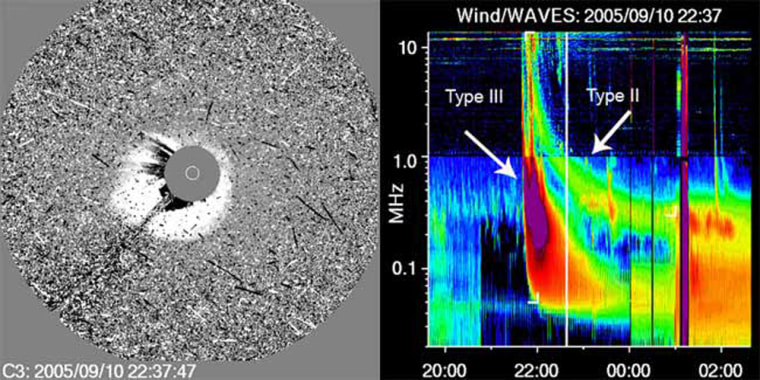Speedy solar storms carrying a billion tons of charged gas through space let out a thunderous scream before they unleash satellite-stopping radiation storms that slam into Earth's magnetic field.
A team of astronomers presented this finding here Tuesday at a meeting of the American Astronomical Society, one that could give astronauts and engineers forewarning of a type of coronal mass ejection capable of showering Earth, spacecraft and space travelers with damaging radiation.
Coronal mass ejections are violent solar eruptions that carry massive amounts of electrically charged gas called plasma from the sun's atmosphere. Once unleashed, these plasma clouds race away from the sun at up to a million miles per hour.
Depending on the orientation of the associated magnetic fields, eruptions directed toward Earth can generate magnetic storms that can flick a giant circuit breaker of sorts, causing widespread power outages.
Radio showers
Some coronal mass ejections also bring intense radiation storms that can disable satellites or cause cancer in unprotected astronauts.
Slideshow 12 photos
Month in Space: January 2014
Here's how these radiation "snowstorms" form: As a coronal mass ejection plows through space, it bumps into the charged particles constantly blown from the sun called the solar wind, resulting in a shock wave. If the shock is powerful enough, it accelerates particles in the solar wind to high speeds capable of triggering radiation storms.
"Some CMEs produce radiation storms, and some don't, or at least the level of radiation is significantly lower," said lead researcher Natchimuthuk Gopalswamy of NASA's Goddard Space Flight Center in Greenbelt, Md.
For instance, the Solar and Heliospheric Observatory has observed more than 10,000 coronal mass ejections over the past 10 years, Gopalswamy said, and only about 1 to 2 percent of them produce these particle storms.
"The trick is to identify the ones that can produce dangerous radiation, so we can warn astronauts and satellite operators," Gopalswamy said.
Radio screams
Gopalswamy and his team may have found a way to do just that. Like the calm before a storm (but louder), they found that coronal mass ejections with shocks capable of unleashing radio storms are preceded by "screams" in radio waves as they barrel through the solar wind.
They analyzed nearly 500 large coronal mass ejections, finding that while the so-called radio-loud outbursts (those that were preceded by "screams") led to radiation storms, none of the more than 150 radio-quiet outbursts were followed by such storms.
Since radio waves travel at the speed of light, the screams could give forewarning of an impending radio, or radiation, storm.
"We can use a CME's radio noise to give warning that it is generating a radiation storm that will hit us soon," Gopalswamy said. "This will give astronauts and satellite operators anywhere between a few tens of minutes to a couple hours to prepare, depending on how fast the particles are moving."
The team also noticed that most of the radio-loud coronal mass ejections came from the sun's equator, a place known as an active region for solar flares, while most of the radio-quiet ejections sprouted from the sun's edges.

